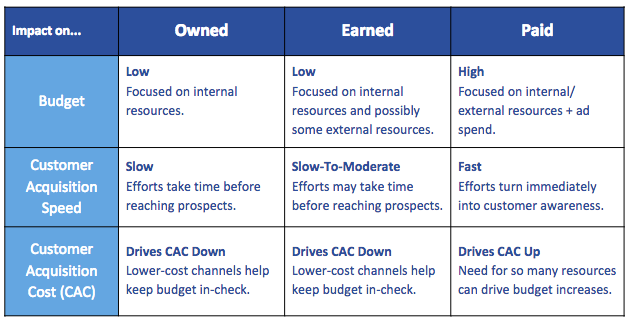One of the biggest struggles with starting out with marketing is figuring out exactly what you want to do. There are so many things you could tackle…but with limited time and resources, it’s often necessary to limit your scope to just a few activities. This is why understanding the difference between earned, owned, and paid marketing is such a critical part of marketing strategy. When you understand these high-level marketing basics, it lets you understand where best to focus your attention given your resources, growth goals, and timelines.
Defining Owned, Earned, and Paid Marketing
First things first, let’s understand exactly what owned, earned and paid marketing really means.

-
Owned Marketing: This refers to any marketing tactics that you, well, own. This means you have complete control over how they look, what they say, and all other details that make them come to life. Classic examples of Owned tactics include your website, social media channels, blog, or email.
-
Earned Marketing: This refers to marketing tactics that you earn as a result of your efforts to make them happen. You can’t directly control whether they happen, but you have the ability, with the right work, to strongly influence them. This includes tactics like customer ratings and reviews, SEO, and PR.
-
Paid Marketing: As the name implies, this refers to marketing activities that you pay for directly. They are 100% pay-to-play tactics, and include things like Facebook or Google ads, Sponsored content, and paid influencers.
The Business Implications of Owned, Earned and Paid Marketing
Each of these marketing activities are beneficial to your business…but they have definite implications on your business and marketing metrics. Let’s look at how these three areas differ.

-
Owned Channels: Because you directly own and control these channels, their impact on..
-
…budget is low. You’ll need a dedicated person to manage these channels, but nothing else. This helps keep costs down.
-
…customer acquisition speed is slow. With limited ways to get directly in front of customers with these channels, gaining awareness and customer interest is a very slow and steady process.
-
…customer acquisition cost drives this metric down. Since there are no major budget implications associated with these tactics, you’ll be able drive down the average cost of acquiring your customers.
-
-
Earned Channels: Because you directly influence, but don’t control these channels, their impact on..
-
…budget is low-to-moderate. A lot of earned marketing is the result of you our your team’s efforts, which helps keep costs low. You may, however, leverage outside help like PR agencies or contractors to support these efforts, which can boost the cost.
-
…customer acquisition speed is slow-to-moderate. These efforts can take some time to reach customers which can limit customer acquisition speed. That said, if some of these efforts are knocked out of the park (e.g. a great press hit), you’ll quickly gain customer awareness.
-
…customer acquisition cost drives this metric down. Just as with Owned channels, there don’t tend to be huge budgetary requirements to tackle these efforts. As a result, you can keep acquisition costs down.
-
-
Paid Channels: Because you directly influence, but don’t control these channels, their impact on..
-
…budget is high. These channels all require you pay money for them to happen, meaning you need to allocate budget to make the run.
-
…customer acquisition speed is fast. Because these efforts can result in your product or service being in front of prospective customers immediately, they can get you customers quickly.
-
…customer acquisition cost drives this metric up. As you can guess, Paid channels mean you’re spending money on acquisition. This means you’re driving acquisition costs up.
-
Typical Examples Of Owned, Earned & Paid Marketing
Let’s take a look at some of the typical tactics that fall under each of these three categories.
Owned Channels
-
Blogs are places to develop rich, high-value content that’s going to draw your prospective customers in. This can take the form of text, images or videos. Regardless of what formats you choose, the secret to great blogs is great content. People will only come to read or watch your content if you create something worthwhile. Making sure you leverage good keyword and SEO strategies, as well as enforce a regular publishing cadence, will help increase the chances of being found naturally on search engines.
-
Social Media includes a whole host of places including Facebook, Twitter, Instagram, Reddit, Quora and many more. As with blogs, being successful at social media requires posting high-quality content on a regular basis, with a keen eye to your audience and what they’re going to find interesting.
-
Email Marketing means sending brand and content messaging to your email database of customer, prospective customers, or general audience. This content can be about new products, new features, a new blog post, or anything else that engages your audience. In fact, it’s a great way to make sure your blog posts (and all the work you put into them) get found.
Earned Channels
-
Ratings & Reviews is the process of getting customers to leave positive feedback about your business on 3rd-party sites like Yelp, Google My Business, and Angie’s List, just to name a few. It requires regular outreach to customers, and having a definite strategy of jump starting your reviews when you starting at zero. This is a great way to take advantage of sites that are trusted and regularly accessed when customers look for advice, especially when you’re still a relatively young business with little awareness.
-
SEO is all about taking on tactics that will help you get ranked in search engines like Bing. Some of the tactics we already discussed, especially creating rich blog content, go a long way to improving the likelihood of being found via search engines, especially if it’s so good that people are linking to it from their sites.
-
PR means getting journalists from newspapers, blogs, TV and other outlets to cover your product or service. You get to leverage their reach to be seen by a wide audiences. It does require you to regularly pitch compelling information to journalists—new product news, seasonal information, etc—that they’ll be interested in and believe their audiences will like.
Paid Channels
-
Google or Facebook Ads require that you have a sizable budget set aside to put ads on their ad platforms. Google Ads are great when you have a product that can easily align with a customers’ search query (e.g. you sell red hats and a person searches for red hats). In contrast, Facebook ads are great for products or services in completely new categories; customers may not know they want it, but when they see the ad they know they will.
-
Sponsored Influencers are individuals who have built their audiences, and will talk about your product or service for a price. Being successful requires finding influencers that reach your core target audience and testing out several influencers to see whose audience really is interested in your product.
-
Conference & Events require you to pay to sponsor, and often have a booth at, venues where your audience will be. They can be a great way to get in front of prospective customers in a concentrated span of time, but they can be pretty hefty investments due to sponsorship costs as well as travel and accommodation expenses.
If you want to learn a bit more, take a look at the presentation we put together for the members of The Riveter to share these marketing fundamentals with new entrepreneurs.





